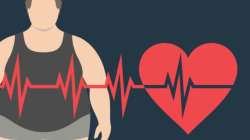Myth or Fact: Exercise must be avoided after a heart attack
Avoiding exercise for the first few weeks after a heart attack may be advised. However, studies show that supervised exercise helps in improving the outcome for all patients. It is important to note that after a heart attack, one should begin a regular activity program to reduce the chance of additional heart problems.

A very common tip to improve heart health is to exercise regularly. But what form of exercise is best for the heart and how much exercise is too much? There have been several myths about the impact of exercise on the heart, while some sound reasonable, there are many that are inaccurate. One such myth is that one should avoid exercising after a heart attack.
Avoiding exercise for the first few weeks after a heart attack may be advised. However, studies show that supervised exercise helps in improving the outcome for all patients. It is important to note that after a heart attack, one should begin a regular activity program to reduce the chance of additional heart problems. Most patients are provided with a prescription for cardiac rehabilitation which entails an exercise program, diet instruction, educational classes on lifestyle changes and emotional support through a peer support group.
While everyone recovers at a different pace, here are a few guidelines that one may follow to get started:
* Consult your doctor before starting exercise. Based on your heart disease, condition, heart function (ejection fraction), rhythm etc. Your doctor will give you an exercise prescription
* It is best to start slow. Once, you get used to walking regularly, you can increase your pace gradually over time. If shortness of breath is felt, it is best to slow down the walking pace
* Exercise should always be done in 3 phases warm-up, peak exercise and cool down, please.
* What helps is walking at a moderate pace for the first 10 minutes the first time and each day tries to a few minutes more. At the end of the month aim to walk for 30 minutes on most days of the week.
* It is important to keep in mind that one should cool down after finishing the exercise by gradually walking at a slower pace for the last 3 minutes.
* If the patient walks outside the house, as a precaution they should walk with someone or in short distances close to home so they do not get too far away.
* One should drink a glass of water to prevent dehydration before you start walking.
* Choose an exercise or an activity that you enjoy doing. For example, walking, cycling, aerobics, etc.
* Doctors' advice should be taken before lifting heavyweights.
* Exercise should be done regularly to ensure benefits. 6 days a week of exercise is advisable.
* Exercising at the same time daily is important to establish a habit. It also minimizes any variable that may impact the exercise.
* If any symptoms such as shortness of breath, chest discomfort, palpitation occur and does not go away, one should stop the exercise and notify the doctor.
* There are several changes that take place after a heart attack like energy levels and medications. This affects exercise tolerance. Therefore it is important to keep the exercise expectation day to day as one goes through the healing process.
If a patient does not go through cardiac rehabilitation, they should begin with gentle exercise after a heart attack. The amount of exercise that is advised to each patient will depend on how active the patient was before the cardiac event and how severe the event was. Overall, one must keep in mind that they should start exercising as soon as they can after a heart attack to get the energy and strength back.